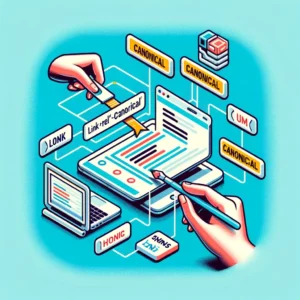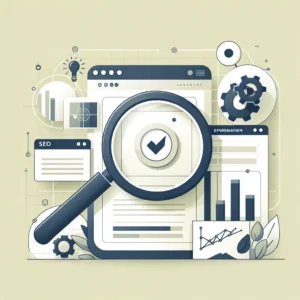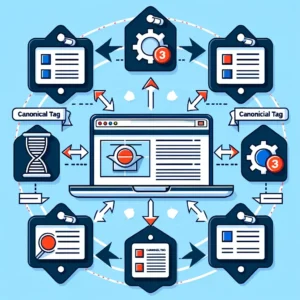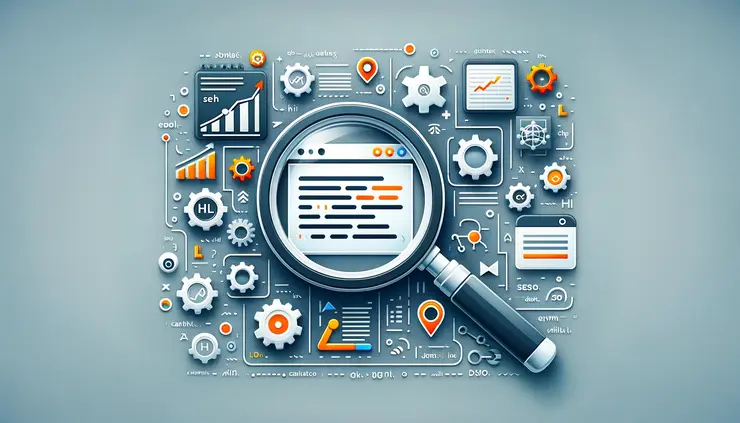In the vast and intricate world of Search Engine Optimization (SEO), canonical tags stand out as a fundamental tool for webmasters and content creators aiming to navigate the challenges of duplicate content. These special HTML elements guide search engines in identifying the “canonical” or preferred version of a web page, ensuring that the correct page is indexed and ranked. By effectively implementing canonical tags, website owners can avoid the pitfalls of content duplication, consolidate page ranking signals, and enhance the visibility and authority of their site in search engine results.
Understanding Canonical Tags and Their SEO Importance
Canonical tags serve as a critical component in directing search engine algorithms on how to correctly index and value the content on your website. This section will delve into what canonical tags are, why they are vital for SEO, and how they play a crucial role in preventing duplicate content penalties and consolidating link equity.
What Are Canonical Tags?
Canonical tags, also known as “rel=canonical”, are a way for webmasters to tell search engines that a specific URL represents the master copy of a page. Implemented in the HTML head of a webpage, these tags help prevent issues related to duplicate content by specifying the “canonical” or “preferred” version of a web page. It’s a way of saying, “Of all the pages with similar content, this one is the most useful. Please prioritize it in search results.”
Why Canonical Tags Matter for SEO
Canonical tags are pivotal for maintaining a healthy and optimized website for several reasons, especially concerning SEO performance and the website’s visibility in search engine results pages (SERPs).
Preventing Duplicate Content Penalties
- Clarifying Content Originality: Search engines aim to provide users with diverse and unique content. When similar or duplicate content appears across multiple URLs on the same website, it can dilute the visibility of each page and confuse search engines on which version to index or rank for query results. By using canonical tags, webmasters can indicate the original version of the content, helping ensure it’s the version that gets indexed and ranked.
- Avoiding Internal Competition: Without a clear canonical version, pages with similar content can end up competing against each other in SERPs, potentially lowering their overall ranking and visibility. Canonical tags help consolidate these pages’ perceived value in the eyes of search engines, reducing self-competition and focusing on improving the rank of the canonical page.
Consolidating Link Equity
- Strengthening Page Ranking: Link equity, also known as “link juice,” refers to the value passed from one page to another via hyperlinks. It’s a crucial factor in SEO as it helps determine a page’s ranking in search results. When multiple pages with similar content exist, the link equity can become diluted as inbound links may point to different versions of the same content. By using canonical tags, webmasters can consolidate link equity towards a single URL, strengthening its authority and improving its potential to rank higher in SERPs.
- Unified Metrics for Accurate Analysis: Canonical tags also allow for more accurate tracking and analysis of metrics by consolidating user engagement, backlinks, and other signals to the canonical page. This unified approach ensures that SEO strategies are based on comprehensive data, allowing for more informed decisions and optimizations.
The Impact of Canonical Tags on Site Performance
Canonicals can have a significant impact on organic performance for site pages, ranging from diluting link equity, declines in keyword rankings, or ensuring that users are provided the best experience through display of the right landing pages in the SERPs.

Improving Page Rankings with Proper Canonicalization
Proper use of canonical tags can significantly boost your page rankings. By clearly signaling to search engines which version of a page is the “master” copy, you help consolidate link equity on a single URL, enhancing its authority and, consequently, its position in search results. This focused approach prevents the dilution of your SEO efforts across multiple, similar pages, directing users and search engines alike to your preferred content.
Enhancing User Experience by Avoiding Content Duplication
Beyond SEO, canonical tags play a pivotal role in enhancing user experience. By preventing content duplication, they ensure that users are directed to the most relevant, authoritative page. This not only improves the efficiency of user navigation but also reinforces the consistency of your site’s information, boosting user trust and engagement. In a digital landscape where user experience is increasingly a ranking factor, such benefits cannot be overstated.
In summary, the judicious application of canonical tags is a cornerstone of modern SEO strategies. Not only do they help improve site performance by bolstering page rankings and enriching user experience, but they also safeguard against the pitfalls of content duplication. By integrating canonical tags into your SEO efforts and ensuring your team fully gravitates their importance, you can significantly enhance the health and effectiveness of your website.
Identifying Pages That Need Canonical Tags
The first step is to conduct a thorough audit of your website to identify duplicate or similar content. Pages that often require canonical tags include:
- Product pages that are accessible through multiple URLs because of tracking parameters or variations (color, size, etc.).
- Content that is accessible through multiple URLs, such as a mobile and a desktop version of your site.
- Articles or blog posts that are published on multiple pages within your site.
Use tools like Google Analytics, Screaming Frog, or SEMrush to help identify duplicate content issues.

How to Add Canonical Tags to Your Website
Implementing canonical tags can be done directly in the HTML of your pages or through your website’s CMS. Both methods are effective, but the approach you choose may depend on your technical expertise and the complexity of your site.
Detail on Implementing Tags in HTML
To add a canonical tag directly to the HTML of a page, you’ll need to insert a link element in the `<head>` section of your HTML document. The syntax looks like this:
<link rel=”canonical” href=”https://www.example.com/preferred-page-url” />
Replace `https://www.example.com/preferred-page-url` with the URL of the page you’ve identified as the canonical version. This tag tells search engines which version of the page to index and rank, effectively consolidating duplicate content.
Detail on Using Content Management Systems for Canonical Tags
Many modern CMS platforms offer built-in support for canonical tags, simplifying the process:
- WordPress: Plugins like Yoast SEO allow you to set canonical URLs for each post and page directly in the WordPress editor.
- Shopify: Automatically uses canonical tags for products and pages but also allows for manual setting if needed.
- Drupal: The Metatag module can be used to set canonical URLs for different types of content.
- Joomla: Extensions like SH404SEF can help manage canonical URLs along with other SEO settings.
When using a CMS, it’s important to familiarize yourself with the platform’s documentation or support forums for specific instructions on adding and managing canonical tags. In many cases, the process is streamlined to make it accessible even for those without technical expertise, allowing you to manage canonical URLs effectively through the administrative dashboard.
Common Mistakes in Canonicalization that Can Impact Rankings
Canonicalization, while a powerful tool in SEO, is often fraught with missteps that can undermine a website’s search engine performance. From improperly set canonical tags to overlooking the nuances of URL parameters, these errors can lead to significant issues, such as diluting link equity or causing content to be overlooked by search engines.

Incorrect Use of Canonical Tags
Canonical tags are a vital part of SEO strategy, guiding search engines to the preferred version of a content piece. However, incorrect usage can lead to several issues.
Pointing to Non-Canonical URLs
- Issue: A common mistake is setting a canonical tag on a page to point to a URL that is not the designated canonical version. This misdirection can confuse search engines, leading to the wrong page being indexed and potentially diluting link equity among multiple versions of content.
- Solution: Always verify that the canonical tag on a page points to the correct, preferred URL. This involves regularly reviewing your site’s content structure and ensuring that any changes in page hierarchy or content focus are accurately reflected in your canonical tags.
Using Canonical Tags When Redirects Are More Appropriate
- Issue: Sometimes, canonical tags are used in scenarios where a 301 redirect would be more suitable. For instance, if a page’s content has moved permanently, using a canonical tag instead of a redirect can keep both URLs active, which may split traffic and authority between them unnecessarily.
- Solution: Use 301 redirects for permanently moved content to consolidate traffic and link equity to the new URL. Reserve canonical tags for situations where multiple versions of a page must exist (e.g., print-friendly versions or product pages with minor variations).
Overlooking Canonical Tags on Similar Content
- Issue: Websites often create content that is similar but targeted for slightly different user intents or keywords. Without proper canonicalization, search engines might see this as duplicate content, which can dilute the site’s overall SEO value.
- Solution: Implement canonical tags to point to the most authoritative page when multiple pages have closely related content. This practice helps consolidate search authority to a single page, improving its ability to rank while ensuring that variations are not competing with each other in search results. Additionally, conducting regular content audits can help identify these situations before they impact your site’s SEO performance negatively.
Tools for Finding Canonical Issues
Fortunately, a variety of sophisticated tools exist to aid webmasters and SEO professionals in finding potential canonical issues with their websites. These tools scan your website, pinpointing canonical tags that are improperly implemented or identifying potential areas of content duplication that may impact your SEO efforts negatively.
Using SEO Auditing Tools
SEO auditing tools play a pivotal role in identifying canonical issues across a website. These tools crawl your website similar to how search engines do, flagging pages with canonicalization problems. They can detect missing canonical tags, multiple canonical tags pointing to different URLs, and pages that should have a canonical tag but don’t. Popular tools like Screaming Frog, SEMrush, and Ahrefs offer comprehensive auditing features that highlight these issues in their reports. After running an audit, you’ll get a list of affected URLs, which you can then analyze to determine the necessary corrections.
Screaming Frog: A Comprehensive Crawler
Screaming Frog SEO Spider is a desktop program widely acclaimed for its deep crawling capabilities. It allows users to analyze and audit technical and onsite SEO issues. One of its core strengths is the ability to identify duplicate content, analyze and generate XML sitemaps, and detect missing, incorrect, or duplicate canonical tags. Screaming Frog is particularly useful for SEO professionals and webmasters looking to conduct detailed audits of their websites. It’s user-friendly yet comprehensive, providing a granular level of control over the crawl and subsequent analysis.
Botify: Advanced SEO Insights
Botify stands out as a cloud-based SEO platform that offers a suite of analytics tools designed for enterprise-scale websites. It provides detailed insights into how search engines interact with your site, highlighting areas for improvement, including canonicalization issues. Botify’s strength lies in its ability to process large volumes of data, offering deep analysis on how to optimize website structure, content, and user experience for better search visibility. Its focus on technical SEO makes it an indispensable tool for large websites seeking to improve their search engine ranking and visibility.
OnCrawl: Data-Driven SEO Optimization
OnCrawl is a robust SEO crawler and log analyzer that helps in making data-driven decisions for your website. It excels in uncovering and resolving technical SEO issues, including problems related to canonical tags. OnCrawl offers detailed reports on duplicate content, site architecture, and performance issues that could affect your site’s SEO performance. Its ability to analyze large sets of data makes it an excellent tool for SEO professionals aiming to optimize their website’s search engine rankings through a thorough understanding of how search engines view their site. By integrating OnCrawl into their SEO strategy, users can ensure their website adheres to best practices for canonicalization and beyond.
SEMRush: An All-encompassing SEO Toolkit
SEMRush is a comprehensive digital marketing toolkit that covers a wide range of functionalities, including SEO, content marketing, competitor analysis, PPC, and social media monitoring. Within its SEO toolkit, SEMRush offers features for auditing websites to identify canonical issues, alongside other on-page SEO problems that could be affecting a site’s visibility and performance in search results. It provides actionable insights and recommendations to improve website health, enhance content quality, and boost search rankings. SEMRush’s ability to track keyword rankings, backlinks, and competitor strategies makes it a versatile tool for marketers aiming to enhance their online presence comprehensively.
Ahrefs: A Powerful Suite for SEO Analysis
Ahrefs is renowned for its advanced SEO analysis tools and capabilities, particularly in keyword research, backlink analysis, and competitive benchmarking. It also includes a Site Audit feature, which is instrumental in identifying various SEO issues, including those related to canonical tags. Ahrefs’ crawler is one of the most powerful on the market, providing users with detailed insights into how search engines may perceive their site. With its intuitive interface and rich data analysis, Ahrefs is a favorite among SEO professionals for diagnosing and resolving a wide array of SEO challenges, including but not limited to, optimizing a website’s canonical strategy to ensure proper indexing and ranking by search engines.
Manual Checks for Canonicalization
While SEO tools are efficient, manual checks are essential for a more thorough examination. This involves inspecting the page source of individual URLs for the presence and correctness of the canonical tag. To perform a manual check, right-click on a page, select “View Page Source,” and search for the “link rel=’canonical’” tag. Verify if the URL defined in the tag is the preferred version of the page. This method is particularly useful for spot-checking critical pages or when you need to confirm the findings from your SEO audit tool.
Prioritizing Canonical Issues for Quick Wins
Addressing canonical issues is a critical step in fine-tuning your website’s SEO strategy, but knowing where to start can be daunting. Prioritizing these issues not only streamlines the optimization process but also ensures you achieve quick wins that can significantly impact your site’s search engine ranking and visibility. This section focuses on strategies to identify and prioritize canonical problems, guiding you through a systematic approach to tackle these issues effectively.
Addressing High-Traffic Pages First
When fixing canonical issues, it’s strategic to start with high-traffic pages. These pages have the most to gain from corrections, as they are likely contributing significantly to your site’s overall performance. Use your web analytics tool to identify these pages, focusing on those that attract the most visitors or have the highest conversion rates. Rectifying canonical issues on these pages can lead to immediate improvements in user experience and search engine visibility, driving more traffic and engagement.
Fixing Canonicalization Across Site Sections
Addressing canonical issues across specific site sections can streamline the process and lead to significant improvements. Start with sections that are most important to your business goals or have the most glaring canonicalization problems. For instance, if your product pages suffer from canonical issues, fixing them can directly impact your sales. By methodically moving through the site section by section, you can ensure a comprehensive cleanup without becoming overwhelmed. This approach also allows for monitoring the impact of changes on each section before moving on to the next, helping to refine your strategy as you go.
Integrating Canonical Tags into Your SEO Strategy
This section outlines a strategic approach to effectively integrate canonical tags into your SEO practices, enhancing your website’s visibility and search engine compatibility.
Regular Review and Maintenance of Canonical Tags
To harness the full potential of canonical tags, it’s essential to adopt a regimen of regular review and maintenance. This involves periodically auditing your site to identify and rectify any incorrectly applied or missing canonical tags. Such diligence ensures that search engines correctly understand and prioritize your content, thereby safeguarding your site against the negative impacts of duplicate content. Tools like Google Search Console can be instrumental in monitoring the effectiveness of your canonical tags and identifying areas for improvement.
Educating Your Team on the Importance of Canonicalization
A successful canonical tag strategy also hinges on the awareness and understanding of your team. Educating content creators, web developers, and SEO specialists about the importance of canonicalization can foster a more cohesive and effective approach to managing duplicate content. Training should cover how to properly implement canonical tags, when to use them, and the ramifications of misuse for site health and SEO performance.
